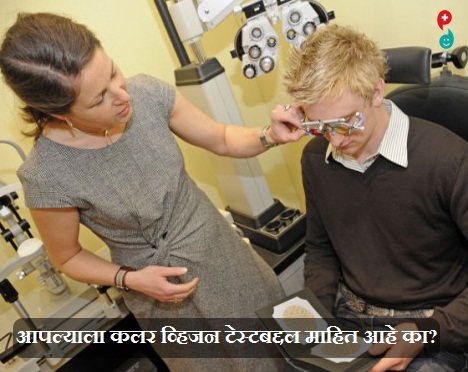Color vision test
A color vision test checks your ability to distinguish between different colors.
How the Test is Performed
You will sit in a comfortable position in regular lighting. The health care provider will explain the test to you.
You will be shown several cards with colored dot patterns. These cards are called Ishihara plates. In the patterns, some of the dots will appear to form numbers or symbols. You will be asked to identify the symbols, if possible.
As you cover one eye, the tester will hold the cards 14 inches (35 centimeters) from your face and ask you to quickly identify the symbol found in each color pattern.
Depending on the problem suspected, you may be asked to determine the intensity of a color, particularly in one eye compared to the other. This is often tested by using the cap of a red eyedrop bottle.
How to Prepare for the Test
If your child is having this test performed, it may be helpful to explain how the test will feel, and to practice or demonstrate on a doll. Your child will feel less anxious about the test if you explain what will happen and why.
Usually there is a sample card of multicolored dots that almost everyone can identify, even people with color vision problems.
If you or your child normally wears glasses, wear them during the test.
Small children may be asked to tell the difference between a red bottle cap and caps of a different color.
How the Test will Feel
The test is similar to a vision test.
Why the Test is Performed
This test is done to determine whether you have any problems with your color vision.
Color vision problems often fall into two categories:
Present from birth (congenital) problems in the light-sensitive cells (cones) of the retina (the light-sensitive layer at the back of the eye) -- the color cards are used in this case.
Diseases of the optic nerve (the nerve that carries visual information from the eye to the brain) -- the bottle caps are used in this case.
Normal Results
Normally, you will be able to distinguish all colors.
What Abnormal Results Mean
This test can determine the following congenital (present from birth) color vision problems:
Achromatopsia -- complete color blindness, seeing only shades of gray
Deuteranopia -- difficulty telling the difference between red/purple and green/purple
Protanopia -- difficulty telling the difference between blue/green and red/green
Tritanopia -- difficulty telling the difference between yellow/green and blue/green
Problems in the optic nerve can show up as a loss of color intensity, although the color card test may be normal.
Risks
There are no risks with this test.
Alternative Names
Eye test - color; Vision test - color; Ishihara color vision test
कलर व्हिजन चाचणी म्हणजे काय?
कलर व्हिजन चाचणी ही वेगवेगळ्या रंगांमध्ये फरक करण्याची तुमची क्षमता तपासते.
चाचणी कशी केली जाते?
नियमित प्रकाशामध्ये आपण आरामदायक स्थितीत बसू शकता.हेल्थ केअर प्रदाता आपल्याला चाचणी बद्दल माहिती देईल. आपल्याला रंगीत डॉट असलेले अनेक कार्डे दर्शविली जातील. या कार्डांना इशिहर प्लेट म्हणतात.नमुन्यांमध्ये, रंगीत ठिपके हे काही संख्या किंवा चिन्हे तयार करत असल्याचे दिसून येईल. शक्य असल्यास, त्या संख्या किंवा चिन्हे ओळखण्यासाठी आपल्याला विचारले जाईल. आपण एका डोळ्याला झाकून ठेवल्यानंतर परीक्षक आपल्या चेहऱ्यापासून 14 इंच (35 सेंटीमीटर)लांबीवर कार्ड धारण करतो आणि प्रत्येक रंग नमुनामध्ये असलेले चिन्ह आपल्याला त्वरीत ओळखण्यास सांगतो.
संशयास्पद समस्येच्या आधारावर,आपल्याला रंगाची तीव्रता ओळखण्यास सांगण्यात येईल, विशेषत: एका डोळ्याच्या तुलनेत दुसऱ्या डोळ्याची तुलना केली जाऊ शकते. याची तपासणी लाल रंगाच्या आईड्रॉप बाटलीच्या टोपीद्वारे केली जाते.
चाचणीसाठी कसे तयार रहावे?
जर आपली मुले हे परीक्षण करणार असेल,तर चाचणी कसा अनुभव देईल याचा अर्थ समजावून सांगणे आणि काय घडेल आणि काय होईल हे आपण समजावून सांगल्यास आपल्या मुलास परीक्षेबद्दल कमी चिंता वाटेल. साधारणपणे तेथे एक बहु-रंगाच्या ठिपक्यांचा नमुना कार्ड असतो जो दृष्टी समस्यांसह सामान्य लोक देखील ओळखू शकतील. जर आपण किंवा आपले मुल सामान्यत: चष्मा घालत असाल, तर चाचणी दरम्यान त्यांना घाला. लाल बाटली ची कॅप आणि वेगळ्या रंगाच्या कॅप्समध्ये फरक सांगण्यासाठी लहान मुलांना विचारले जाऊ शकते.
चाचणी चा कसा अनुभव येईल?
चाचणी दृष्टीक्षेप चाचणी सारखीच आहे.
चाचणी का केली जाते?
आपल्याला विविध रंग ओळखण्यात कोणत्या समस्या आहेत किंवा नाही हे निर्धारित करण्यासाठी ही चाचणी केली जाते.
कलर व्हिजन समस्या बहुतेक वेळा दोन श्रेणींमध्ये येतात:
रेटिना (डोळ्याच्या मागे प्रकाश-संवेदनशील स्तर)च्या प्रकाश-संवेदनशील पेशी मधील जन्मजात समस्या - या प्रकरणात रंग कार्डे वापरली जातात.
ऑप्टिक तंत्रिका (डोळा पासून ब्रेन पर्यंत व्हिज्युअल माहिती पोहचवणारी तंत्रिका)रोग - या प्रकरणात बाटली कॅप्स वापरली जातात.
सामान्य परिणाम म्हणजे काय?
सामान्यपणे,आपण सर्व रंगांमध्ये फरक करण्यास सक्षम असाल.
असामान्य परिणाम म्हणजे काय?
हे चाचणी खालील कलर विजन जन्मजात समस्येचे (जन्मापासून उपस्थित)निर्धारित करू शकते:
आक्रोटोप्सिया - संपूर्ण रंग अंधत्व, फक्त राखाडी रंगांचा देखावा
ड्यूटेरानोपिया - लाल / जांभळा आणि हिरव्या / जांभळा यांच्यातील फरक सांगण्यात अडचण आणत आहे
प्रोटानोपिया - निळ्या / हिरव्या आणि लाल / हिरव्यामधील फरक सांगण्यात अडचण आणत आहे
ट्रायटनोपिया - पिवळा / हिरवा आणि निळा / हिरवा दरम्यान फरक सांगण्यात अडचण आहे
ऑप्टीक नर्वमधील समस्या कलर तीव्रता कमी झाल्याचे दर्शवितात, जरी रंग कार्ड चाचणी सामान्य असू शकते.
चाचणी चे धोके:
या चाचणीसह कोणतेही धोके नाहीत.
पर्यायी नावे
डोळा चाचणी -रंग; दृष्टीक्षेप -रंग; इशिहर रंगीन दृष्टीक्षेप










